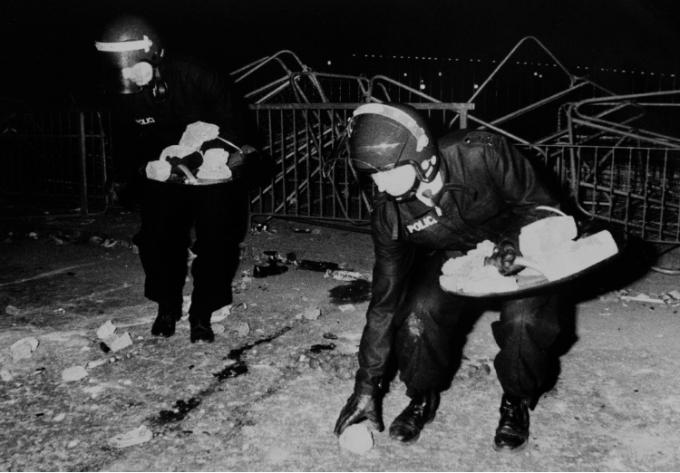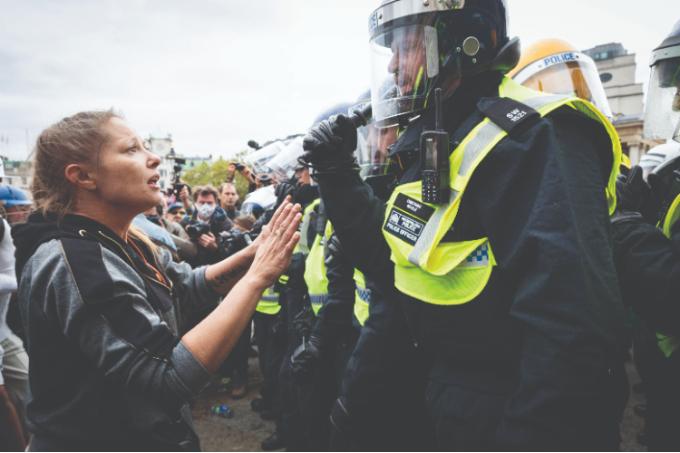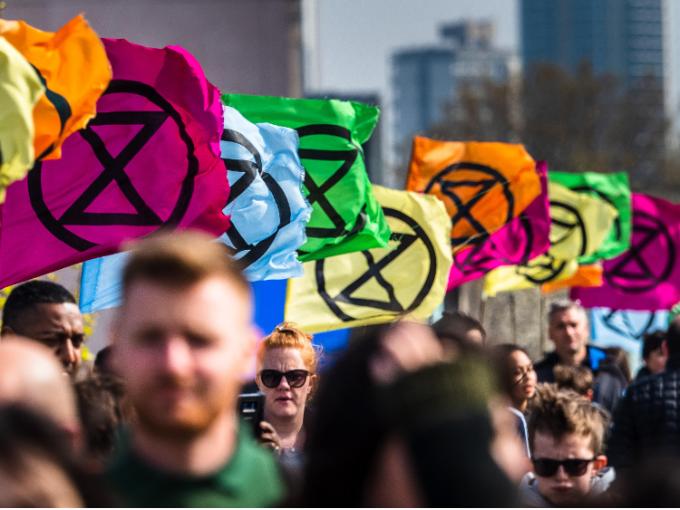'This Is Going To Create More Conflict With The Police, Not Less': What Will The Policing Bill Mean for Protest?
Protesters from environmental campaign group Extinction Rebellion block the road outside London City Airport, October 2019 [Credit: Penelope Barritt/Alamy]
10 min read
New proposed powers to limit disruptive protests have driven activists back onto the streets. But are the new proposals bringing necessary balance and protection through police powers, or posing a fundamental threat to democracy? Georgina Bailey reports
Bob Broadhurst choked on his coffee when he read the explanatory notes for the Policing, Crime, Sentencing and Courts Bill. “They’re saying protestors are now using new tactics – they’re locking themselves in, they’re gluing themselves down, they’re blocking roads. They were doing that 30 years ago,” says the retired Metropolitan police commander, who was gold command for the policing of the 2009 G20 protests and now lectures at the London Policing College. “That’s classic Reclaim the Streets tactics [of the 1990s]; that’s Swampy tactics. None of that has changed. None of the tactics are new.”
Others give different examples, including the suffragette movement and Gandhi. Even trying to block the distribution of News International’s newspapers isn’t a novel tactic, with print unions doing so to protest job losses 35 years ago. “They didn’t do anything about The Times building back in the 1980s when we spent weeks helping Rupert Murdoch get his newspapers out of his new site in Wapping and got attacked,” Broadhurst says.
Nearly all public order legislation which exists in England and Wales is a response to different protest and policing trends, and the latest proposals in the Policing, Crime, Sentencing and Courts Bill (clauses 54 to 60) are no different.
The National Police Chiefs Council (NPCC) say the new powers they have requested are not in response to any one group, but instead to manage ongoing changes in public disorder – including an increase in the number of static protests compared to marches and the ability of groups to mobilise quickly over social media – and to tidy up previous gaps. However, government documents on the new protest powers explicitly reference Extinction Rebellion (XR) and Black Lives Matter (BLM), referring to the “disproportionate impact on commuters and small businesses” and £37m policing costs for two extended XR protests in 2019, as well as the 172 police officers injured by a violent minority in the BLM protests last summer.
While Her Majesty’s Inspectorate of the Constabulary and Fire and Rescue Services has given the powers in the bill its “qualified support,” opinions vary on whether it will limit the impact of XR or similar protests. More broadly, activist movements, lawyers and former police officers who spoke to The House are concerned about the impact it could have on damaging police-community relations and limiting other smaller protests in England and Wales.

Police clear up missiles thrown at them during a night of violence in the dispute between print unions and Rupert Murdoch's News International at Wapping, 4 May 1986 [Credit: Alamy]
So what are the powers included in the bill which are causing such controversy?
The bill doesn’t ban protests, and the government is clear that it doesn’t intend to. However, it does give the police very broad powers to impose more or less any conditions on assemblies, marches and even one-person protests, and lowers the threshold for doing so.
These conditions can be imposed where police reasonably believe the noise or disruption generated by the protest may have a significant detrimental impact on persons or businesses in the vicinity. This includes harassment, intimidation, serious unease, alarm or distress, and breaking these conditions could result in a fine or up to 51 weeks imprisonment. The bill also allows the police to impose any conditions on an assembly they reasonably believe could cause “disorder, damage, disruption, impact or intimidation” – bringing it into line with current laws on conditions on marches.
As recommended by the Law Commission, the bill would also abolish the common law offence of public nuisance and replace it with a new statutory offence of “intentionally or recklessly causing public nuisance” – complete with sentencing of up to 10 years in prison.
"If you look at the number of times we apply conditions, it is comparatively very few" - Chief Constable BJ Harrington
What constitutes “serious unease” is yet to be defined – the government has set out considerations which will be taken into account in police decision-making to ensure the threshold is “appropriately high” (for example, length of protest, proximity to places such as schools and doctors’ surgeries) but guidance will come later.
Chief Constable BJ Harrington of the NPCC says this is common practice for police powers. “We’ve got to be proportionate, legal and necessary in terms of any conditions that we apply. If you look at the number of times we apply conditions, it is comparatively very few.”
However, others believe this approach leaves too much power in the hands of police without proper legislative scrutiny.

A protester tries to talk to the the Metropolitan police after they moved in on the Unite for Freedom rally after alleged reports they had broke the Covid risk assessment, 26 September 20202 [Credit: Alamy]
Lochlinn Parker, the head of civil liberties at ITN Solicitors, says: “It is going to be down to police officers to try and determine a highly nebulous idea: what is annoying? Everybody is annoyed when a protest takes over the street, but lowering that [threshold] significantly is creating a situation where, if minded to, there will be very little protest that would be lawfully allowed.
“Police will be asked, as they frequently are by the government and the press, why wasn’t more done to stop this protest which caused disruption and problems,” Parker goes on. “The political pressure on the police, and potentially their own inclinations in terms of keeping control and order, is going to come to the fore.”
This notion of political and public pressure on the police when it comes to public order policing was mentioned by several serving and former senior officers The House spoke to – highlighted by the challenges of policing in the pandemic, where lockdown legislation on protest was unclear and the public relationship with the police came under increased strain.
“With a rolling news media and social media, the context is often lost or ignored on policing protests, and colleagues do feel that they are damned if they do, and damned if they don’t,” says John Apter, chair of the Police Federation, who is worried by the increased violence police face. “Police officers can be deployed into a situation without the full protective equipment because it may look too aggressive, and then they’ll get injured. Then they’ll go into another protest with the full public order kit, and we’ll be accused of being too military like, so it’s always trying to find the balance.”
“Any legislation has got to be crystal clear as to what’s expected from both the public and those who are expected to enforce it,” Apter says.
"What the government has done here is lower the threshold for physical intervention and the use of coercive power" - Retired chief superintendent Owen West
After the death of newspaper vendor Ian Tomlinson at the hands of the Metropolitan Police during the G20 protests in 2009 (something Broadhurst was questioned under caution over), then-HMIC produced a report called Adapting to Protest: Nurturing the British Model of Policing. This set out four principles for public order policing: education, communication, differentiation between different protestors and facilitation.
Retired chief superintendent Owen West, who managed public order incidences including English Defence League marches in West Yorkshire, says: “What the bill will do is potentially negate the last two, facilitation and differentiation.
“This is going to create more conflict with the police, not less. The government might have a view that if they are putting more and more restrictions on it might help the police, it might reduce the number of protests, it might make protests [shorter]. But the reverse is true. What the government has done here is lower the threshold for physical intervention and the use of coercive power.
“We’re going to see more and more small p and big P political pressure on the police to use the powers that this bill gives. That will cause more physical conflict between the protest community and the police than we’ve ever seen before.”
The debate around the bill goes to the heart of the challenges faced in managing different human rights: the right of people to protest and the right of everyone else to live their life unimpinged.
Clifford Stott, a professor of social psychology at Keele University and expert in protest and police behaviour, argues that, although he vehemently disagrees with the proposals, under the Human Rights Act, the police will not be able to enforce any elements of the legislation which interfere with Articles 10 and 11 of the European Convention on Human Rights – freedom of expression and freedom of assembly and association. The primacy of the Human Rights Act and the role of the police in protecting and balancing those rights is also something that Chief Constable Harrington repeatedly emphasises.

Extinction Rebellion protest on Waterloo Bridge in Central London, closing the bridge to traffic,15 April 2019 [Credit: Alamy]
Because of this, Stott believes the bill will not deter XR or other large-scale disruptive protest groups. “It doesn’t really offer that much that’s different. At some level, this is a piece of legislation that could loosely be characterised as a little bit of grandstanding. A government that wants to position itself as having done something... but actually underneath it doing very little at all.”
However Stott also has a warning: “If then subsequently this government or a subsequent government scraps the Human Rights Act, then those protections would no longer exist, and the government and police could interfere with those protected rights.”
Many warn of a “chilling effect” on the willingness of smaller groups, with fewer legal resources, to protest. Others fear the measures could lead to protests being less organised and therefore more violent, with people less likely to volunteer to organise and coordinate with police if they face increased sentences or fines. It may also increase the risk of extremist infiltration.
"We cannot permit groups using disruptive and dangerous tactics to trample on the rights of local businesses and communities" - Policing minister, Kit Malthouse
Undoubtedly, the bill plays into the very question about the nature of protest and its role in a democracy. “Obviously, protest is by its very nature noisy, it’s disruptive, it’s there to be seen and to be heard. If this bill goes ahead, then it will effectively render protest meaningless, because you just won’t be able to have any sort of impact locally or on the national stage,” West says.
His former colleagues, Broadhurst, Apter and Barrington, all raise the point of peaceful versus lawful when it comes to protest. Like West, many officers are also worried about the recent drain of skills from the police, and the resources available to properly manage protest.
Broadhurst says: “How do you stop 10,000 people who’ve decided to go and stand outside Parliament making a noise? You can have all the powers in the world, but if they all decided to turn up and bring a megaphone and shout loudly, what are you going to do?”
He believes the ambition of the bill should be scaled back so that it is focused on regularising existing powers.
“There is a danger of setting them up to fail,” he warns.
Policing minister Kit Malthouse defended the bill, however. He said: “The right to protest is a cornerstone of our democracy and the government is absolutely committed to maintaining freedom of expression – and there is nothing in this bill which will ban protest or stop people exercising these rights.
“But we also must strike a balance between the rights of protesters and the rights of others to go about their lawful business. We cannot permit groups using disruptive and dangerous tactics – whether gluing themselves to train carriages or blocking traffic, including emergency vehicles – to trample on the rights of local businesses and communities.
“These new measures will not deny people their fundamental right to protest and be heard, but they will strike a better balance with the equally important rights of others and the unimpeded operation of our democracy.”
